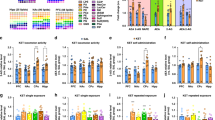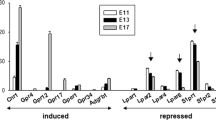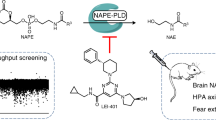Abstract
The functions of 2-arachidonoylglycerol (2-AG), the most abundant endocannabinoid found in the brain, remain largely unknown. Here we show that two previously unknown inhibitors of monoacylglycerol lipase, a presynaptic enzyme that hydrolyzes 2-AG, increase 2-AG levels and enhance retrograde signaling from pyramidal neurons to GABAergic terminals in the hippocampus. These results establish a role for 2-AG in synaptic plasticity and point to monoacylglycerol lipase as a possible drug target.
This is a preview of subscription content, access via your institution
Access options
Subscribe to this journal
Receive 12 print issues and online access
$209.00 per year
only $17.42 per issue
Buy this article
- Purchase on SpringerLink
- Instant access to full article PDF
Prices may be subject to local taxes which are calculated during checkout


Similar content being viewed by others
Change history
12 December 2006
Our paper identified 6-methyl-2-p-tolylaminobenzo[d]oxazin-4-one (URB754; Specs) as a monoacylglycerol lipase (MGL) inhibitor that enhances hippocampal depolarization-induced suppression of inhibition (DSI). However, in subsequent tests of non-commercial URB754, we failed to replicate these results, suggesting that a bioactive impurity was present in the commercial material. We have identified this impurity as bis(methylthio)mercurane (Supplementary Results online). Because this compound interacts with multiple targets, we tested another MGL inhibitor, methylarachidonylfluorophosphonate (MAFP), which prolonged DSI (Fig. 1), confirming that monoacylglycerol lipase contributes to the termination of DSI, as others have reported1. Another generation of endocannabinoid metabolism inhibitors is needed to test this hypothesis further.
References
Freund, T.F., Katona, I. & Piomelli, D. Physiol. Rev. 83, 1017–1066 (2003).
Wilson, R.I. & Nicoll, R.A. Nature 410, 588–592 (2001).
Ohno-Shosaku, T., Maejima, T. & Kano, M. Neuron 29, 729–738 (2001).
Wilson, R.I., Kunos, G. & Nicoll, R.A. Neuron 31, 453–462 (2001).
Piomelli, D. Nat. Rev. Neurosci. 4, 873–884 (2003).
Cravatt, B.F. et al. Nature 384, 83–87 (1996).
Dinh, T.P. et al. Proc. Natl. Acad. Sci. USA 99, 10819–10824 (2002).
Kim, J. & Alger, B.E. Nat. Neurosci. 7, 697–698 (2004).
Porter, A.C. et al. J. Pharmacol. Exp. Ther. 301, 1020–1024 (2002).
Huang, C.C., Chen, Y.L., Lo, S.W. & Hsu, K.S. Mol. Pharmacol. 61, 578–585 (2002).
Hohmann, A.G. et al. Nature 435, 1108–1112 (2005).
Kathuria, S. et al. Nat. Med. 9, 76–81 (2003).
Krantz, A. et al. J. Med. Chem. 33, 464–479 (1990).
Hodson, H.F. et al. International patent application PCT WO 00/40247 (2000).
Acknowledgements
We thank N. Hájos for valuable comments and J. Kim for help with cultures. This research was supported by grants from the US National Institute on Drug Abuse and the University of California Discovery Program (D.P.); from Ministero Istruzione Università e Ricerca and University of Urbino 'Carlo Bo' and University of Parma (G.T. and M.M.); and from the Howard Hughes Medical Institute, US National Institutes of Health, European Union Framework Programme 6 and Országos Tudományos Kutatási Alapprogramok (T.F.F).
Author information
Authors and Affiliations
Corresponding authors
Ethics declarations
Competing interests
The authors declare competing financial interests: a patent was filed on behalf of D.P., A.D., A.T., M.M. and G.T. by the University of California, Irvine; the University of Urbino and the University of Parma.
Supplementary information
Supplementary Fig. 1
The effect of URB602 on DSI is mediated by CB1 receptors. (PDF 184 kb)
Supplementary Fig. 2
URB602 does not affect depolarization-evoked Ca2+ transients in hippocampal CA1 pyramidal neurons. (PDF 635 kb)
Supplementary Fig. 3
URB754 and URB602 do not inhibit FAAH activity in rat forebrain slice cultures. (PDF 562 kb)
Supplementary Fig. 4
Effects of a high concentration of URB754 (3 μM) on hippocampal DSI. (PDF 1137 kb)
Supplementary Table 1
Kinetic analysis of the effects of URB754 on the activity of recombinant rat brain MGL expressed in HeLa cells. (PDF 38 kb)
Rights and permissions
About this article
Cite this article
Makara, J., Mor, M., Fegley, D. et al. Selective inhibition of 2-AG hydrolysis enhances endocannabinoid signaling in hippocampus. Nat Neurosci 8, 1139–1141 (2005). https://doi.org/10.1038/nn1521
Received:
Accepted:
Published:
Issue Date:
DOI: https://doi.org/10.1038/nn1521



